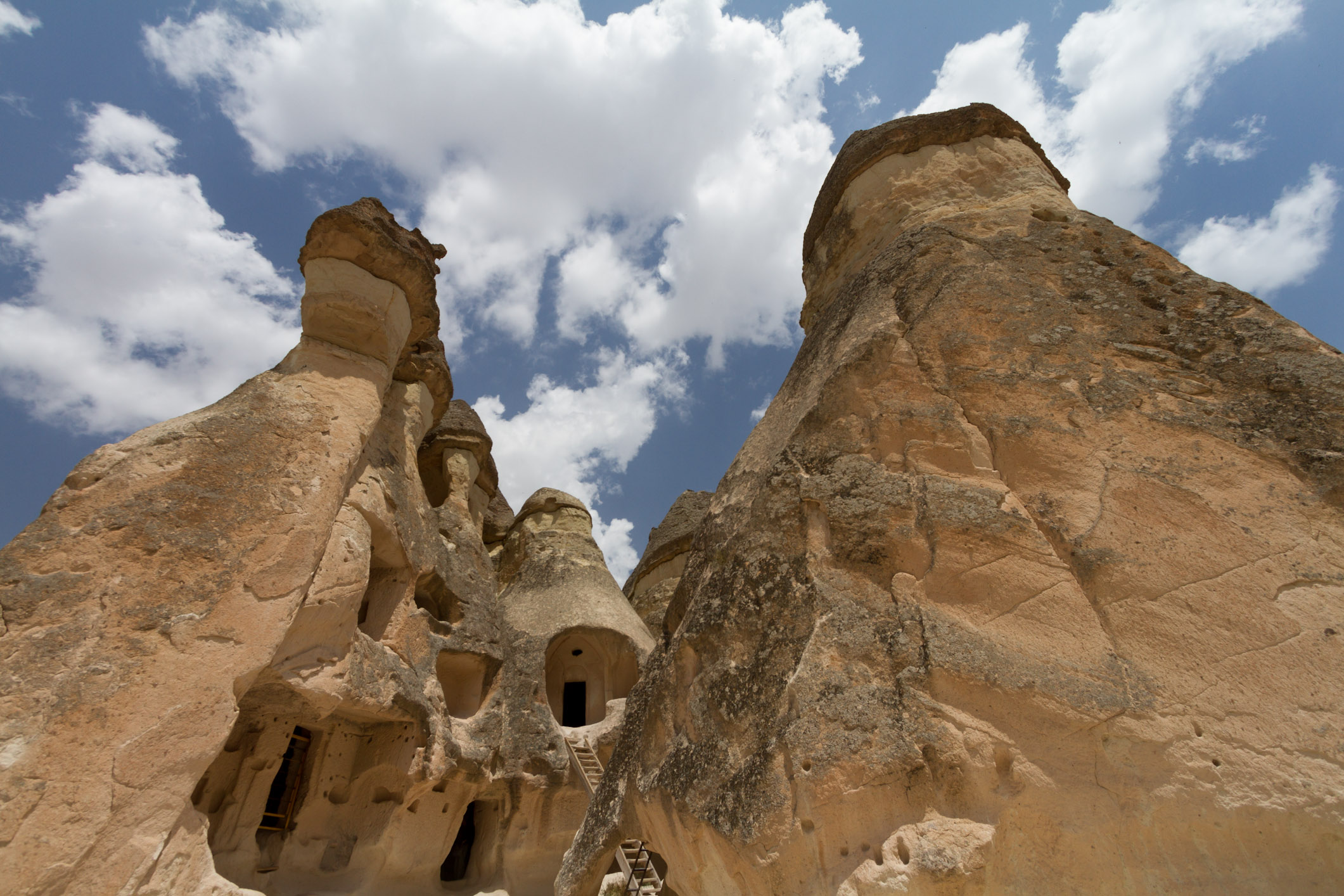
Credit: Benh LIEU SONG, CC BY-SA 2.0, via Wikimedia Commons
Background
Synopsis: The Cappadocian region of central Turkey is renowned for its otherworldly geological formations called fairy chimneys. These surreal structures rise dramatically from the ground, creating an awe-inspiring landscape. These formations, shaped over millions of years, are not only natural wonders but also served as shelters and fortifications for human civilizations.
Formation of Fairy Chimneys
- Around 55 million years ago, during the Cenozoic Era, the Arabian tectonic plate collided with the Eurasian plate. This tectonic interaction caused the uplift of Anatolia, the landmass that now forms most of Turkey.
- The resulting deformation created a plateau and spurred the formation of large stratovolcanoes like Mount Erciyes (12,851 feet/3,917 meters) and Mount Hasan (10,673 feet/3,253 meters) which still dominate Cappadocia’s landscape.
- Over millions of years, the region experienced numerous eruptions, depositing thick layers of volcanic ash.
- The ash eventually hardened into tuff—a lightweight, porous rock composed of compressed volcanic material.
- Subsequent lava flows added a harder basalt layer on top of the tuff. Basalt, being more resistant to erosion, played a crucial role in preserving the strata beneath it.
- The Cappadocian climate, characterized by significant temperature fluctuations and strong winds, promoted extensive erosion. Freeze-thaw cycles, in which water seeps into cracks and expands when frozen, further broke down the rock.
- Over time, the softer tuff eroded away, leaving behind towers and cones of rock “held up” by basalt caps. These capped formations resemble mushrooms or chimneys.
- The variation in minerals within the volcanic material created a stunning array of colors, from soft white and pink to rich reddish-brown hues, enhancing the region’s unique aesthetic.
- Local differential erosion of these different rock types resulted in fairy chimneys of diverse shapes and sizes, ranging from sharp spires to rounded towers.
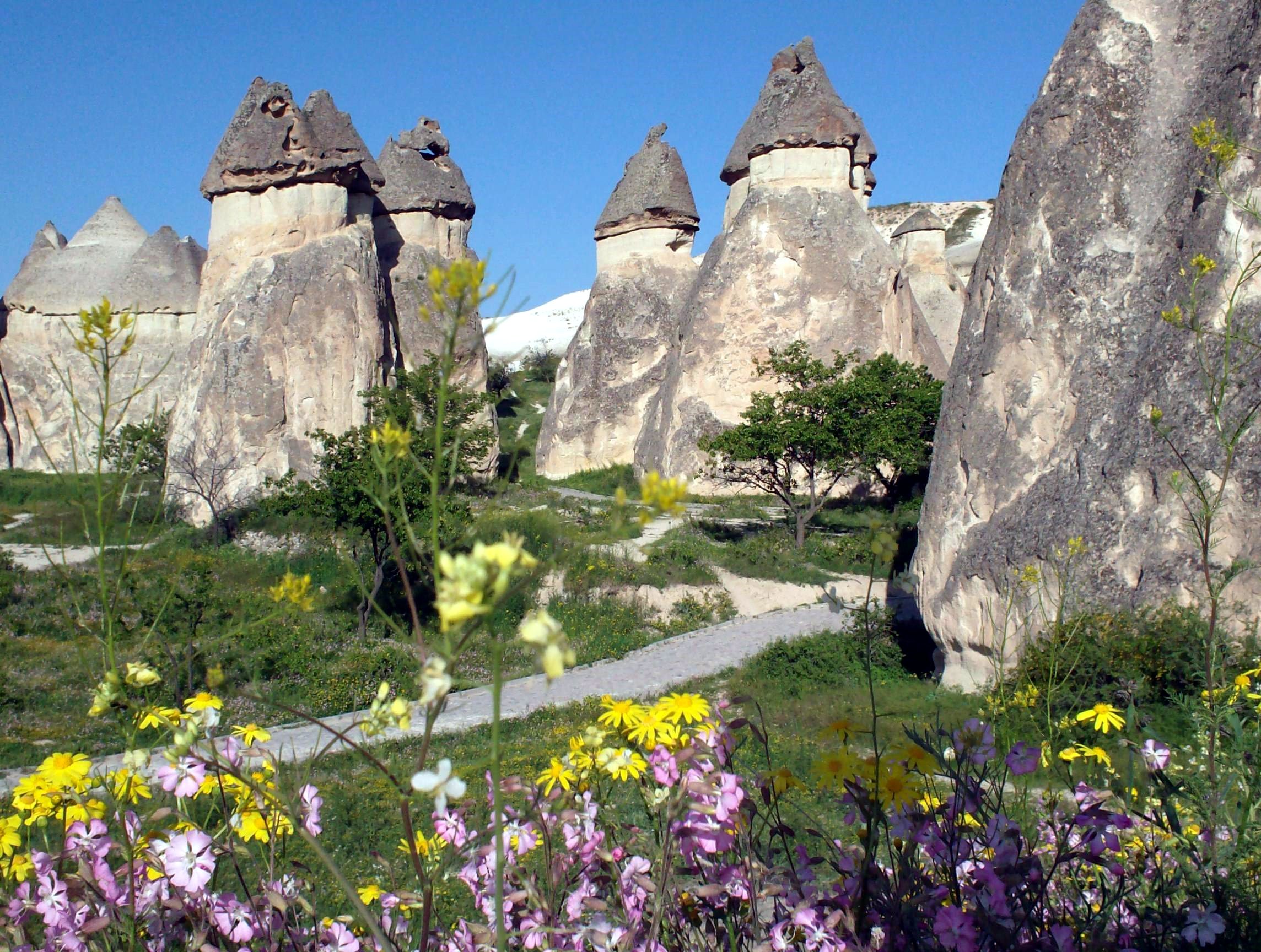
The fairy chimneys in the Göreme valley of the Cappadocia region are comprised of soft tuff rock that is sculpted by erosion and topped with a resistant layer of basalt, forming a mushroom-like cap on each column.
Credit: Murat Özsoy 1958, CC BY-SA 4.0, via Wikimedia Commons
Early Inhabitants
- As early as 1800 BCE, the Hittites recognized the malleability of tuff and carved caves, tunnels, and shelters into the rock. These early constructions provided protection from the elements and invading forces.
- The region’s strategic location made it a contested area for centuries, witnessing the rise and fall of Greek, Persian, Byzantine, and Roman influences.
- Cappadocia became a vital trade hub along the ancient Silk Road, further integrating it into the fabric of multiple empires.
- During the fourth century CE, Christian communities fleeing persecution form the Roman Empire found refuge in Cappadocia.
- These early Christians established monastic settlements, carving intricate churches, monasteries, and homes directly into the rock. Many of these rock-hewn churches featured vibrant frescoes, some of which remain well-preserved today.
- By the medieval period, Cappadocia was a melting pot of cultures including Greek, Turkish, Armenian, and Syrian influences.
- The region’s inhabitants adapted the fairy chimneys and cliffs into homes, stables, storage facilities, and places of worship, blending functionality with artistic expression.
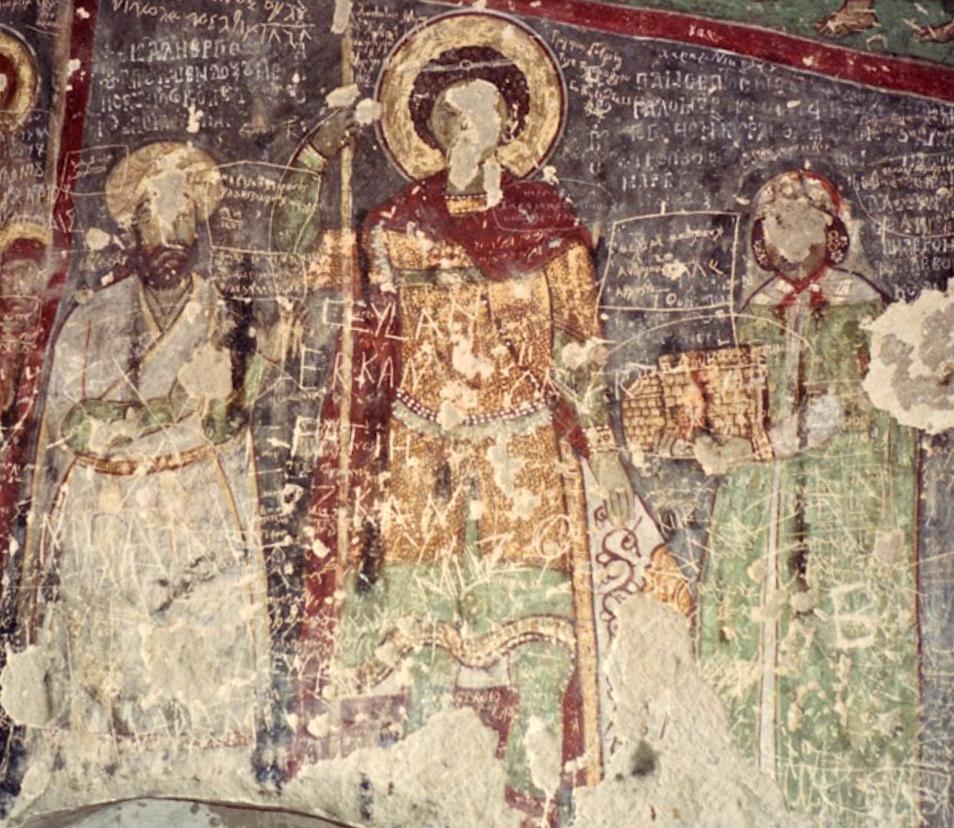
This painting inside one of the churches depicts Saint Basil the Great who served as a bishop of the early church in Cappadocia from 370 until his death in 379.
Credit: Zorlusert, CC BY-SA 3.0, via Wikimedia Commons
Underground City
- In 1963, a homeowner in the town of Derinkuyu made an astonishing discovery while renovating his basement. When he knocked down a wall, he uncovered a tunnel leading to a vast underground city.
- Archeologists later found that this was just one of nearly 600 such entrances scattered across Cappadocia.
- The Derinkuyu underground city extends 280 feet (76 meters) below the surface and comprises 18 levels, though only eight levels are accessible today.
- It could house approximately 20,000 people, along with their livestock and supplies, making it one of the largest underground cities in the world.
- The first levels are believed to have been carved by the Hittites around 1200 BCE, with later expansions attributed to the Phrygians, a skilled civilization known for their advanced architecture.
- Early Christians fleeing persecution expanded the city further during the Byzantine period (6th – 10th centuries), adding churches, schools, and convents.
- Rolling stone doors, weighing up to half a ton, could seal off tunnels to protect inhabitants from invaders.
- Over 50 ventilation shafts, which vary from 230 – 280 feet (70 – 85 meters), ensure a steady supply of fresh air throughout the city, even at its deepest levels.
- Lower levels were used for storing food and wine, keeping them at stable temperatures.
- Mid-levels contained areas for animals, churches, and communal gatherings.
- The underground city offered refuge during invasions, even as late as the Mongol raids in the 14th century, and from extreme weather conditions.
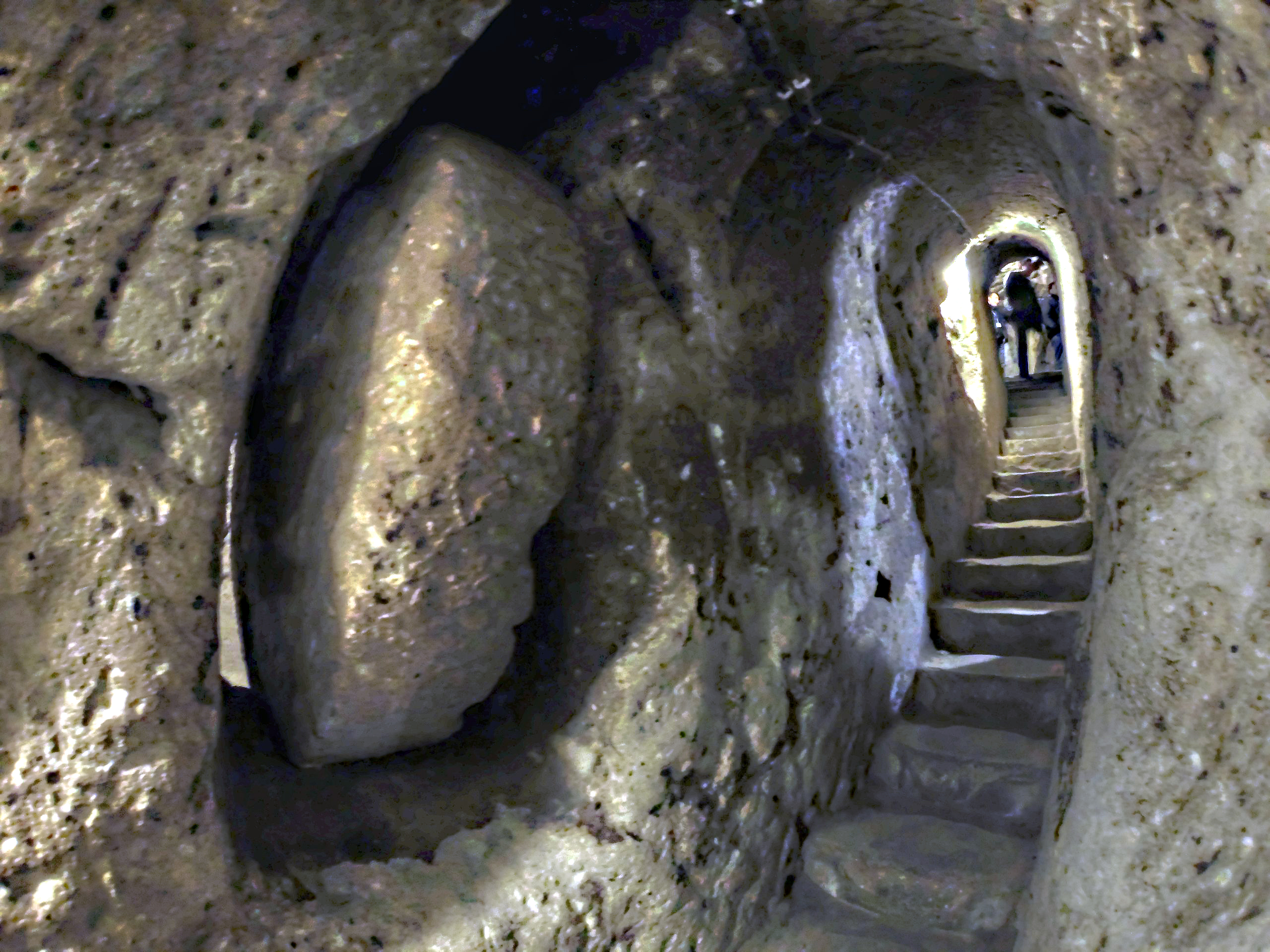
A stairway and one of the large stone doors that could be rolled into place to block intruders into the underground city of Derinkuyu.
Credit: Nevit Dilmen, CC BY-SA 3.0, via Wikimedia Commons
Preservation of the Region
- In 1985, the Göreme Valley and Rock Sites of Cappadocia were designated as a UNESCO World Heritage Site. This recognition highlights the region’s unique geological, historical, and cultural significance.
- The landscape is a masterpiece of both natural erosion and human ingenuity, with its fairy chimneys, rock-hewn churches, and underground cities.
- Byzantine sanctuaries, adorned with frescoes, showcase the artistic achievements of early Christian communities.
- Millions of visitors flock to Cappadocia each year to explore its caves, valleys, and underground wonders. Hot air balloon rides have become an increasing popular method to view the unique landscape.
- Efforts are ongoing to preserve this fragile landscape from the impacts of increasing tourism as well as natural degradation.
- Cappadocia remains a living testament to the interplay between nature’s forces and human resilience, ensuring its stories and structures endure for years to come.
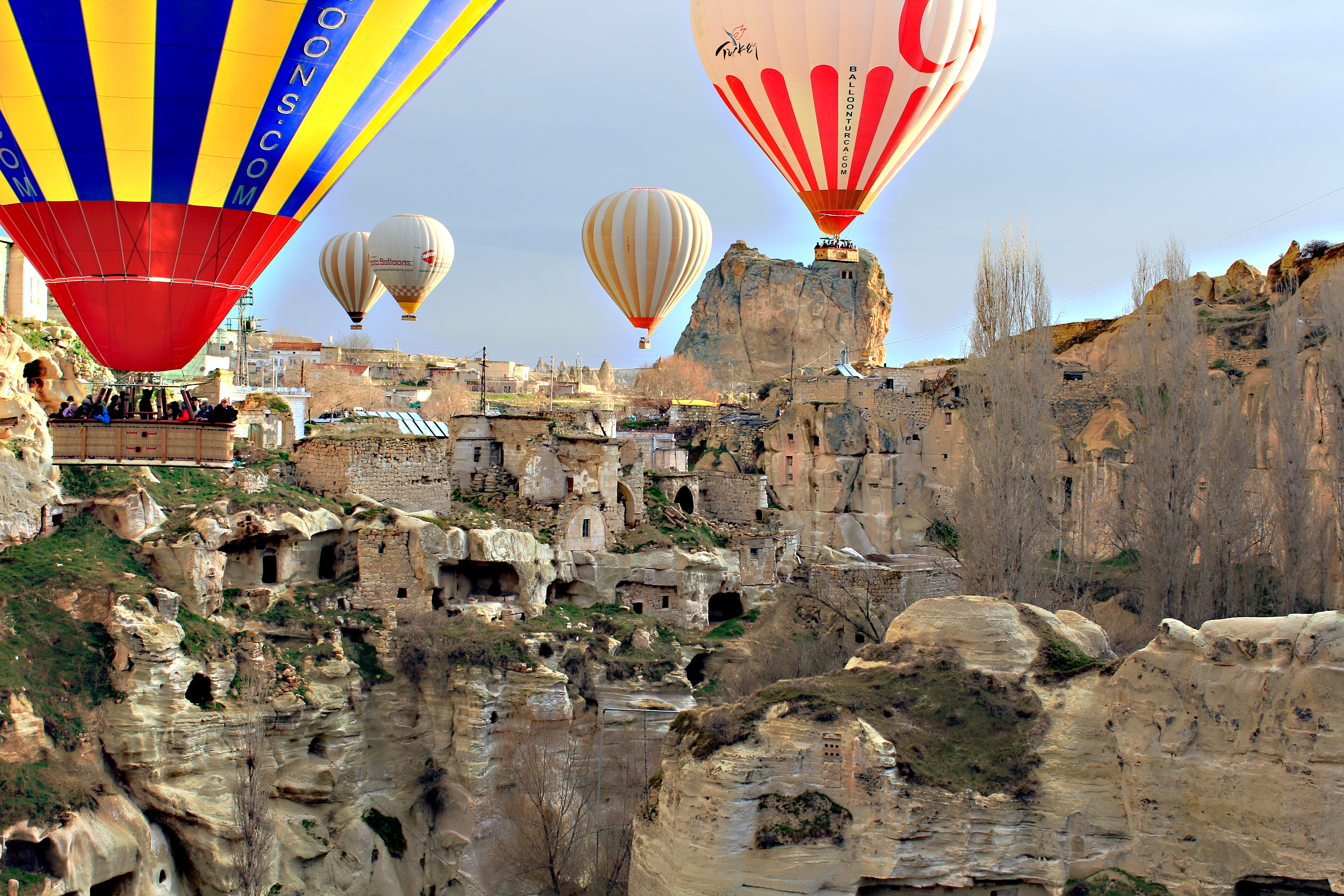
Ballooning has become a very popular way for tourists to view the fairy chimneys and hillside dwellings in and around Cappadocia.
Credit: Arian Zwegers, CC BY 2.0, via Wikimedia Commons
Episode script
Sixty years ago in central Turkey, a homeowner made a remarkable discovery.
When remodeling his basement, he knocked down a wall and found a tunnel. He followed the tunnel to find one of the largest underground cities in the world, abandoned long ago.
When scientists explored it, they discovered it went down 18 levels, 280 feet into the ground, and was once home to some 20,000 underground dwellers.
This was in the region known as Cappadocia, where ancient volcanoes formed soft, porous rock called tuff. On the surface it eroded into tall spires called fairy chimneys. Underground, water seeped in to form caves, which early cultures excavated further.
Around 3,000 years ago, the Hittites began to carve the underground city of Derinkuyu. It was expanded by Christians throughout the Middle Ages.
In the cool, lowest levels they stored grain and wine. In the middle levels they kept livestock. The highest levels were residences. A network of ventilation shafts brought fresh air to all.
The underground city provided shelter from the weather, and from invaders.
Central Turkey, at the crossroads of the Silk Road, was a frequent stop for marauding armies. Derinkuyu residents rolled massive stone doors across entrance tunnels to protect inhabitants.
From 1500 AD until today the city was forgotten. But it’s now a UNESCO protected site, and a remarkable window into the past.

